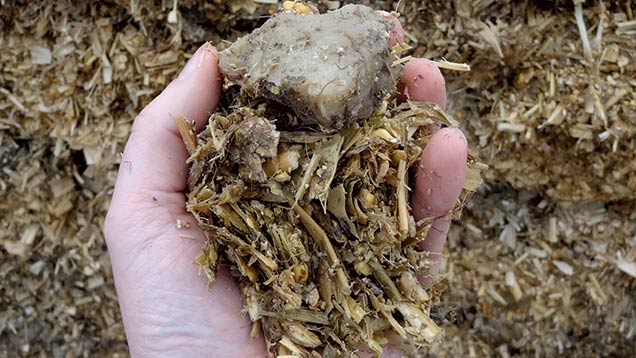Replacing wholecrop and barley with beta-maize saves farmer £120 a head

By replacing wholecrop and barley with the high-energy forage crop beta-maize, beef finisher Ben Hargreaves has saved £120 a head on feed costs.
Mr Hargreaves, from Tittenley Farm, Market Drayton, Shropshire, first started feeding beta-maize in 2013 after reading about the concept in Farmers Weekly.
“I wanted to use fodder beet through the summer, which we couldn’t do with fresh fodder beet, and I also wanted to replace wholecrop, which was too expensive at the time,” he explains.
See also: Cut costs by feeding co-products to dairy bull calves
Beta-maize first appeared in Denmark, where 33% crushed fodder beet was ensiled with 67% maize, but the concept is slowly being adopted by a handful of UK farmers.
In total, Mr Hargreaves grows 30ha of fodder beet. About 300t is fed on-farm and the rest is sold. In 2014 he bought in 130t of maize at a cost of £32/t delivered, and ensiled it with 40t of home-grown fodder beet.
The process
“We plant the fodder beet late March to mid-April, depending on the weather, and harvest it in October – about 10 days before we receive the maize, which gives it some time to dry out,” he explains.
The beet is dry-cleaned through a sugar beet cleaner to remove excess dirt before it is ensiled.
- Maize yielded 17.3t/ha at 32% DM and 115% starch
- Fodder beet yielded 18.4t/ha at 22.7% DM
- The 2014 crop of steers averaged 300kg carcass weight while the heifers averaged 280kg
“The cleaner rolls the beet around and rubs it a bit, making the excess soil fall off.
“We are actually on heavy soil here, which is probably more of a challenge, so it is quite important to harvest it in good conditions, when the ground isn’t wet or sticky.”
Despite these challenges, the
dirt tare of the 2013 crop was low at just 9.3%, which made ensiling it easier.
After cleaning, the beet is then chopped through a Harry West side-discharge muckspreader prior to ensiling and is alternately layered in the clamp, starting with 1m of maize in a ratio of one part fodder beet to four parts maize.
“We have to steam wash the muckspreader. We’ve found it gives us the right chop size. It breaks the beet into three or four pieces rather than pulping it down into finer pieces. We don’t want it chopped too finely because the sugar juices will run out into the maize.
“We spread about a 1m layer of maize in the pit first, and using a loader bucket we spread a thin layer of fodder beet. There’s quite a skill to it,” he adds.
Feeding
Mr Hargreaves replaced the wholecrop and ground barley from his 2013 ration with beta-maize last year (see tables below).
The clamp was opened in April and the mix was fed to the finished cattle until September in the form of a TMR throughout the fattening period, explains Mr Hargreaves, who runs a herd of 65 Limousin-cross suckler cows and buys in store cattle to finish.
Mr Hargreaves’ adviser, Richard Hopwood from ACT, says it increased dry matter intakes during the fattening period by 0.5kg an animal and saved them 96p a head a day – resulting in an overall saving of £120 a head during the fattening period.
“The beta-maize diet has seen finished days pushed back a little by 14 days. But even on an alternative diet it shows days to finishing are not compromised by a large amount,” adds Mr Hopwood.
This year Mr Hargreaves has ensiled an additional 70t of beta-maize, and despite the fall in cereal price still estimates he will save 90p a head a day.
Mr Hargreaves adds: “By growing home-grown forage you are not vulnerable to the price peaks and troughs of cereal prices or the volatility of the grain market. It is a more consistent cost.”
2013 total mixed ration (before including beta-maize)
|
Amount |
Feed type |
Cost |
Cost per animal |
|
6kg |
Red clover silage |
£30/t |
18p |
|
6kg |
Wholecrop |
£80/t |
48p |
|
5kg |
Ground barley |
£160/t |
80p |
|
5kg |
Grains and beet |
£60/t |
30p |
|
0.2kg |
Limestone |
£150/t |
3p |
|
0.2kg |
Minerals |
£320/t |
6p |
|
8kg |
Straw |
£60/t |
48p |
|
Total |
£860 |
£2.33 |
2014 total mixed ration (before including beta-maize)
|
Amount |
Feed type |
Cost |
Cost per animal |
|
4kg |
Red clover silage |
£30/t |
12p |
|
6kg |
Beet |
£30/t |
18p |
|
7kg |
Beta-maize |
£35/t |
25p |
|
5kg |
Grains and beet |
£50/t |
25p |
|
0.2kg |
Limestone |
£150/t |
3p |
|
0.2kg |
Minerals |
£320/t |
6p |
|
8kg |
Straw |
£60/t |
48p |
|
Total |
£675 |
£1.37 |
Tips on ensiling and feeding from John Spence, seed sales specialist at Limagrain
- An early maturing variety of maize should be used (maturity class 9/10) to allow the harvest of crops to take place simultaneously in October
- Aim to get maize DM at 32% so it isn’t to wet when it’s clamped or it will lose energy
- When choosing fodder beet varieties choose a clean root with a low dirt tare to prevent contamination with a high DM – above 18%
- The beet should be into pieces of 5-10cm
- For best results use 25% fodder beet to 75% maize
- Cows will sort for fodder beet, which can cause acidosis if eaten in excess. Avoid selective feeding by not putting a huge amount in front of them and spreading it evenly along the feed passage
